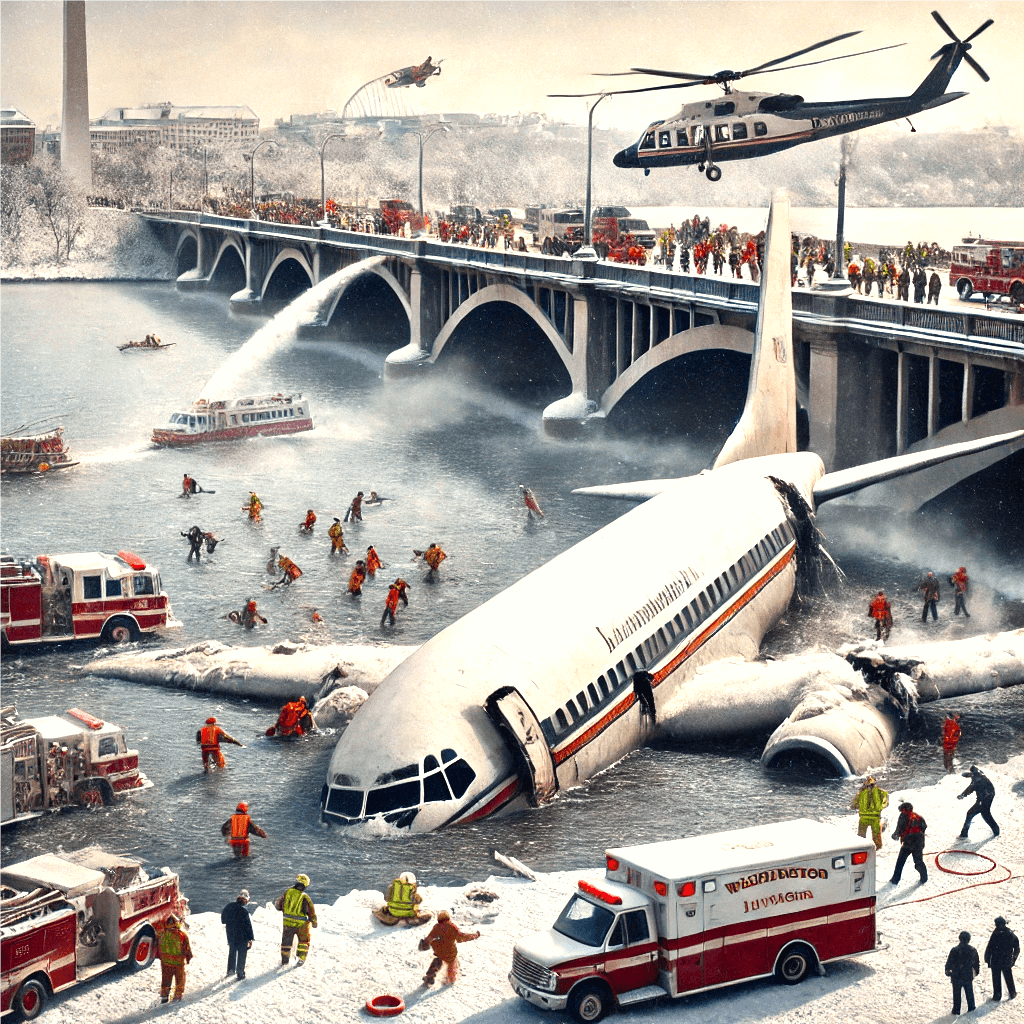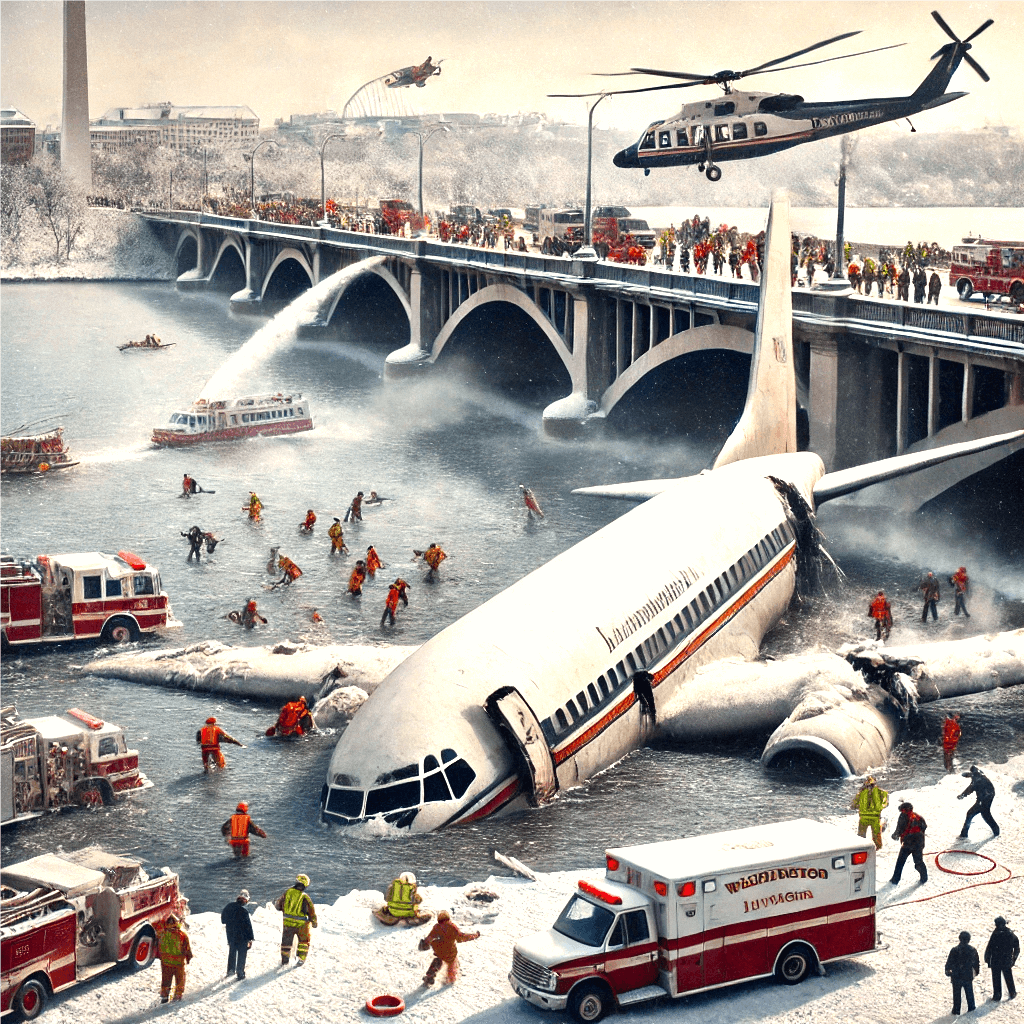Table of Contents
Washington, D.C., being the seat of the government and the hugging the center of the aviation industry, has been a site of several significant plane crashes during its existence. Although flying is rather an infallible way of traveling, airplane crashes remain a dark reality in certain scenarios especially in zones with a sensitive level of air traffic and site security. The following discussion unfolds the most devastating plane crashes connected to Washington D.C alongside their aftermaths and the reasons why they took place and what was learnt from them.
Air Florida Flight 90 – The Potomac River Crash (1982)
Another outstandingly catastrophic airplane crash to ever happen in Washington, D.C took place on January 13, 1982, when Air Florida Flight 90 flew directly into the frozen Potomac River in shocking style after colliding with the 14th Street Bridge while on a flight from Washington National Airport now called Reagan National Airport. The fateful Boeing 737-200 was heading towards Tampa, Florida.
Four motorists located on the bridge’ s road died after a plane accidently crashed into the bridge.
The remaining 73 passengers along with the 6 crew members on board the aircraft also died when the plane plummeted into the river. Because of the harsh climate, water temperatures, and remoteness of the area, saving anyone became near impossible.
One passenger however displayed incredible courage. Arland D. Williams Jr. tried to save as many people possible by throwing out different rescue lines but sadly gave into the freezing water.
An investigation for the National Transportation Safety Board (NTSB) indicates that the pilots did not properly attempt to de ice the airplane while on the runway. During the taking off procedure, engine power sieges were eranously set up and calculated. Along with corrective, practical but stringent policies and procedures, pilots will now also receive proper training on handling planes in winter.
9/11 Attack on The Pentagon
A Boeing 757 repesenting American Airlines was hijacked, collectedly referred as flight 77. With the intent to crash the airplane into the Pentagon, American Airlines took off from Dulles International Airport in Virgina with 64 other passengers alongside the 125 members seating within the Pentagon. On September 11 of 2001, it became one of the korean terrorities. Greenlight crash into America’s most notorious building, killing all survivors.
The events of September 11 along with the World Trade Center incident in New York are part of the broader coordinated attacks. As a result of the crash, a massive level of destruction occurred which led to a subsequent fire which lasted for hours. Consequently, aviation security procedures were significantly revamped, which led to the formation of the TSA, improvement of airport security checks, reinforcement of cockpit doors, and improvement of air traffic control procedures.
White House Intrusion-Cessna 150 Crash (1994)
Yet another shocking and alarming aviation incident took place on September 11 in the year 1994 whern Frank Corde, a disgruntled, angry, and drunk person, hijacked a Cessna 150 and crashed it into the White House’s South Lawn. Corder was the only casualty in this incident, but he raised alarm pertaining safety problems surrounding the air space in the Capital of the United States.
This incident led to the national authorities introducing further restrains to the borders air space of Washington D.C which eventually therefore led to the creation of a restricted flight zone within the National Capital Region (P-56 airspace). Now missile defense systems along with fighter jets are on constant alert to protect the restricted airspace from incoming aircrafts which do not have clearance.
Other Significant Aviation Events
For some of the non-fatal incidences that have taken place in the vicinity of Washington, D.C., there are many aircraft related incidents while to some, the events are fatal. Some examples that are remarkable are:
Eastern Air Lines flight 537 (1949): Over the Washington National Airport, there was a mid-air accident between a passenger plane for Eastern Air Lines and a P-38 military aircraft. The passenger plane crashed and all 55 occupants lost their lives. The accident was blamed on the military pilot not yielding the right-of-way.
TWA Flight 514 (1974): A Boeing 727 in thick fog crashed into a ridge in the vicinity of Dulles international airport, causing all 92 passengers aboard the flight to lose their lives. This tragedy shed light on the need for improved communication among air traffic control as well as cockpit altitude awareness, and these were actioned after the incident.
Highly commended change brought forth after major aviation incidents is in regards to aviation safety which promises something of this sort does not repeat itself. Some most important alterations entail:
Improved De-Icing Procedures: The aviation ace has changed procedures for de-icing and within pilots, trained more to recognize dangers brought forth by ice after the Accident of Air Florida Flight 90.
Enhanced Airspace Security: The National mall plus the White House has to adhere to one of the most strict airspace regulations, which now include missile defense systems and F-16 fighter jets.
Stronger Cockpit Security Measures – As a result of the 9/11 attacks, cockpit doors were reinforced around the world to prevent hijackers from easily taking control of an aircraft.
Better Pilot Training and Technology Improvements – Training programs have become more intensive, and the evolution of TAWS and TCAS have lowered the chances of mid-air collisions and controlled flight into terrain significantly.
Improved Air Traffic Communication – The case of TWA Flight 514 exhibited the need for specific terminology to be used by pilots and air traffic controllers so that miscommunication does not occur.

Conclusion
Despite the aviation accidents that have occurred in Washington, D.C., every incident has encouraged the aviation industry to improve safety standards. Through enhanced national security measures, improved aircraft de icing procedures, and increased awareness, these mishaps have proved to be valuable. Without a doubt, air travel today is safer than it has ever been, thanks to everything learned through these incidents. Still, there is a growing need to maintain safeguards for future tragedies, particularly as technology and threats continue to change.
If you are interested for more: Martyrs: 5 Powerful Days of Remembrance and Reverence Washington, D.C. Plane Crashes 2025: A Chronicle of Disaster and What We Have Learnt



